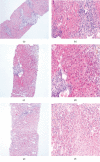Autoimmune Hepatitis-Immunologically Triggered Liver Pathogenesis-Diagnostic and Therapeutic Strategies
- PMID: 31886312
- PMCID: PMC6899271
- DOI: 10.1155/2019/9437043
Autoimmune Hepatitis-Immunologically Triggered Liver Pathogenesis-Diagnostic and Therapeutic Strategies
Abstract
Autoimmune hepatitis (AIH) is a severe liver disease that arises in genetically predisposed male and female individuals worldwide. Diagnosis of AIH is made clinically applying diagnostic scores; however, the heterotopic disease phenotype often makes a rapid determination of disease challenging. AIH responds favorably to steroids and pharmacologic immunosuppression, and liver transplantation is only necessary in cases with acute liver failure or end-stage liver cirrhosis. Recurrence or development of de novo AIH after transplantation is possible, and treatment is similar to standard AIH therapy. Current experimental investigations of T cell-mediated autoimmune pathways and analysis of changes within the intestinal microbiome might advance our knowledge on the pathogenesis of AIH and trigger a spark of hope for novel therapeutic strategies.
Copyright © 2019 Elisabeth Sucher et al.
Conflict of interest statement
The authors declare that there is no conflict of interest regarding the publication of this paper.
Figures




References
Publication types
MeSH terms
Substances
LinkOut - more resources
Full Text Sources

